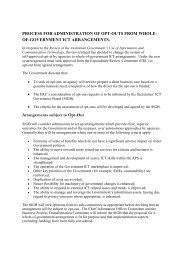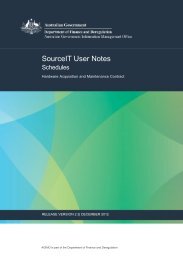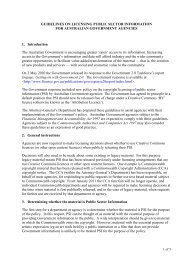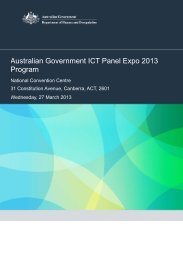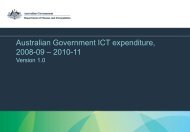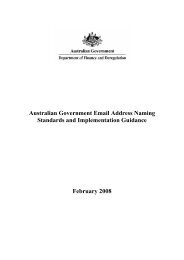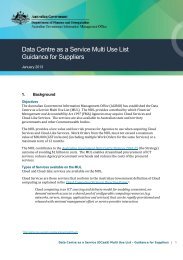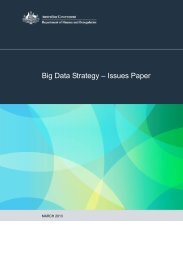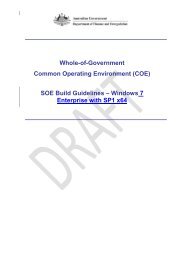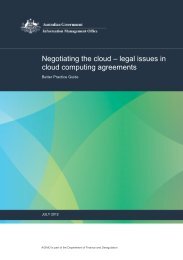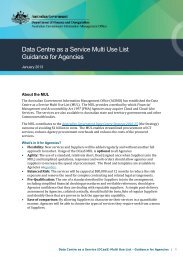Email Protective Marking Standard for the Australian Government
Email Protective Marking Standard for the Australian Government
Email Protective Marking Standard for the Australian Government
You also want an ePaper? Increase the reach of your titles
YUMPU automatically turns print PDFs into web optimized ePapers that Google loves.
1.2 AudienceThis <strong>Standard</strong> is intended <strong>for</strong> in<strong>for</strong>mation technology professionals involved in <strong>the</strong>development, configuration or administration of email infrastructure components usedby <strong>Australian</strong> <strong>Government</strong> agencies.This <strong>Standard</strong> may have some relevance to in<strong>for</strong>mation technology professionals whodevelop, configure or administer <strong>the</strong> email infrastructures of non-governmentorganisations who exchange messages with <strong>Australian</strong> <strong>Government</strong> agencies. Theseorganisations may wish to exchange email messages with government agencies thatcontain protective markings compliant with this <strong>Standard</strong>.1.3 Pre- and co-requisite readingThis <strong>Standard</strong> should be read in conjunction with RFC2822 [4]. This <strong>Standard</strong> utilisesin<strong>for</strong>mation in RFC2822 wherever possible. Ideally, <strong>the</strong> reader should also be familiarwith <strong>the</strong> Augmented Backus-Naur Form syntax, as defined in RFC2234 [5].The <strong>Standard</strong> relies on concepts and definitions promulgated in <strong>the</strong> <strong>Australian</strong><strong>Government</strong> In<strong>for</strong>mation Security Management Protocol.The <strong>Australian</strong> <strong>Government</strong> Recordkeeping Metadata <strong>Standard</strong> version 2.0, July 2008(AGRkMS) [6] sets out <strong>the</strong> type of in<strong>for</strong>mation that agencies should capture in astructured way to describe <strong>the</strong> identity, au<strong>the</strong>nticity, content, structure, context andessential management requirements of records and includes a standard set ofmetadata <strong>for</strong> use with email messages. Agencies are also referred to <strong>the</strong> AGRkMSImplementation Guidance (June 2011) prepared by <strong>the</strong> National Archives of Australia.1.4 AssumptionsThe assumptions made by this <strong>Standard</strong> are that:• <strong>the</strong> message <strong>for</strong>mat used by <strong>the</strong> communicating parties is RFC2822 2• email receiving agents will not experience fatal software exceptions on receipt ofa message with an arbitrarily long Subject field 3• email receiving agents will not experience fatal software exceptions on receipt ofa message with an Internet Message Header Extension field.2 This does not mean <strong>the</strong> message necessarily was transmitted over <strong>the</strong> Internet, only that it uses <strong>the</strong> RFC2822 standard <strong>for</strong> <strong>for</strong>matting <strong>the</strong>email message.3 The agents may not be able to display arbitrarily long Subject fields but such Subject fields will not cause a software exception in <strong>the</strong>m.7



